2017 MERCEDES-BENZ CLA trunk
[x] Cancel search: trunkPage 144 of 318
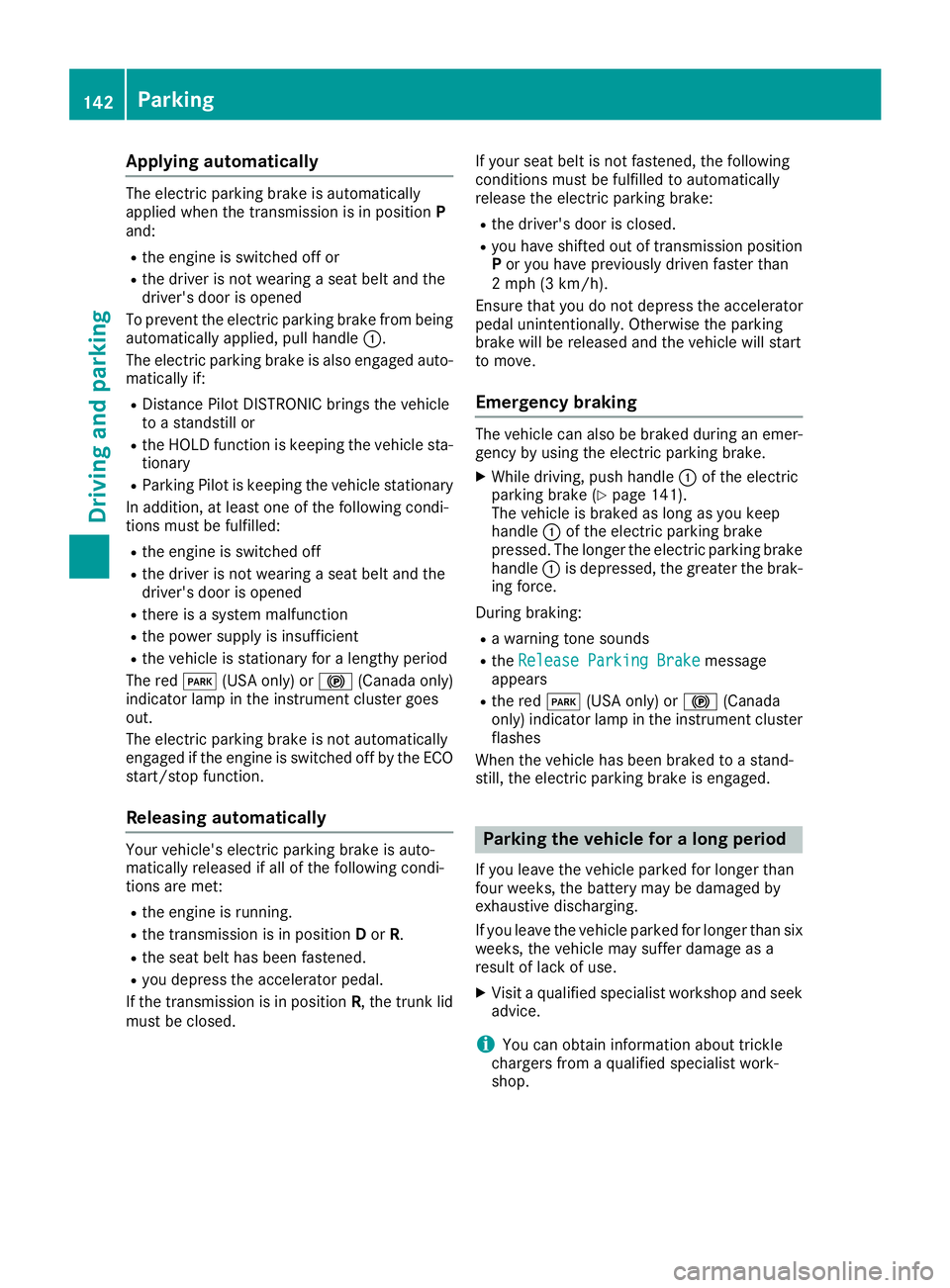
Applying automatically The electric parking brak e is automatically
applie d when th e transmission is in position P
and : R
th e engin e is switched off orR
th e driver is no t wearing a seat belt and th e
driver's door is opened
To preven t th e electric parking brak e from bein g
automatically applied, pull handle �C .
The electric parking brak e is also engage d auto -
matically if: R
Distanc e Pilo t DISTRONI C bring s th e vehicl e
to a standstill orR
th e HOLD function is keepin g th e vehicl e sta-
tionary R
Parking Pilo t is keepin g th e vehicl e stationary
In addition , at least on e of th e followin g condi-
tion s mus t be fulfilled :R
th e engin e is switched offR
th e driver is no t wearing a seat belt and th e
driver's door is opened R
there is a system malfunctionR
th e powe r supply is insufficien tR
th e vehicl e is stationary for a lengthy period
The red �I (US A only) or �$ (Canada only)
indicator lamp in th e instrumen t cluste r goe s
out .
The electric parking brak e is no t automatically
engage d if th e engin e is switched off by th e ECO
start/sto p function .
Releasing automatically Your vehicle's electric parking brak e is auto -
matically release d if all of th e followin g condi-
tion s are met :R
th e engin e is running.R
th e transmission is in position D or R .R
th e seat belt has been fastened.R
you depress th e accelerato r pedal .
If th e transmission is in position R , th e trunk lid
mus t be closed. If your seat belt is no t fastened, th e followin g
condition s mus t be fulfilled to automatically
release th e electric parking brake: R
th e driver's door is closed. R
you hav e shifte d out of transmission position
P or you hav e previously driven faste r than
2 mph (3 km/h).
Ensur e that you do no t depress th e accelerato r
pedal unintentionally. Otherwise th e parking
brak e will be release d and th e vehicl e will start
to move.
Eme rg ency brakingThe vehicl e can also be braked during an emer-
gency by usin g th e electric parking brake. X
Whil e driving, push handle �C of th e electric
parking brak e ( Y
page 141).
The vehicl e is braked as lon g as you keep
handle �C of th e electric parking brak e
pressed. The longer th e electric parking brak e
handle �C is depressed, th e greate r th e brak -
ing force .
During braking : R
a warning tone sounds R
th e Releas e Parkin g Brake message
appear s R
th e red �I (US A only) or �$ (Canada
only) indicator lamp in th e instrumen t cluste r
flashes
When th e vehicl e has been braked to a stand -
still, th e electric parking brak e is engaged.
Pa rk ing the vehicle for a long period If you leav e th e vehicl e parked for longer than
four weeks, th e battery may be damaged by
exhaustive discharging.
If you leav e th e vehicl e parked for longer than six
weeks, th e vehicl e may suffer damag e as a
result of lack of use. X
Visit a qualified specialist workshop and see k
advice .
i You can obtain information about trickle
chargers from a qualified specialist work-
shop.142
Parking
Driving and parking
Page 159 of 318
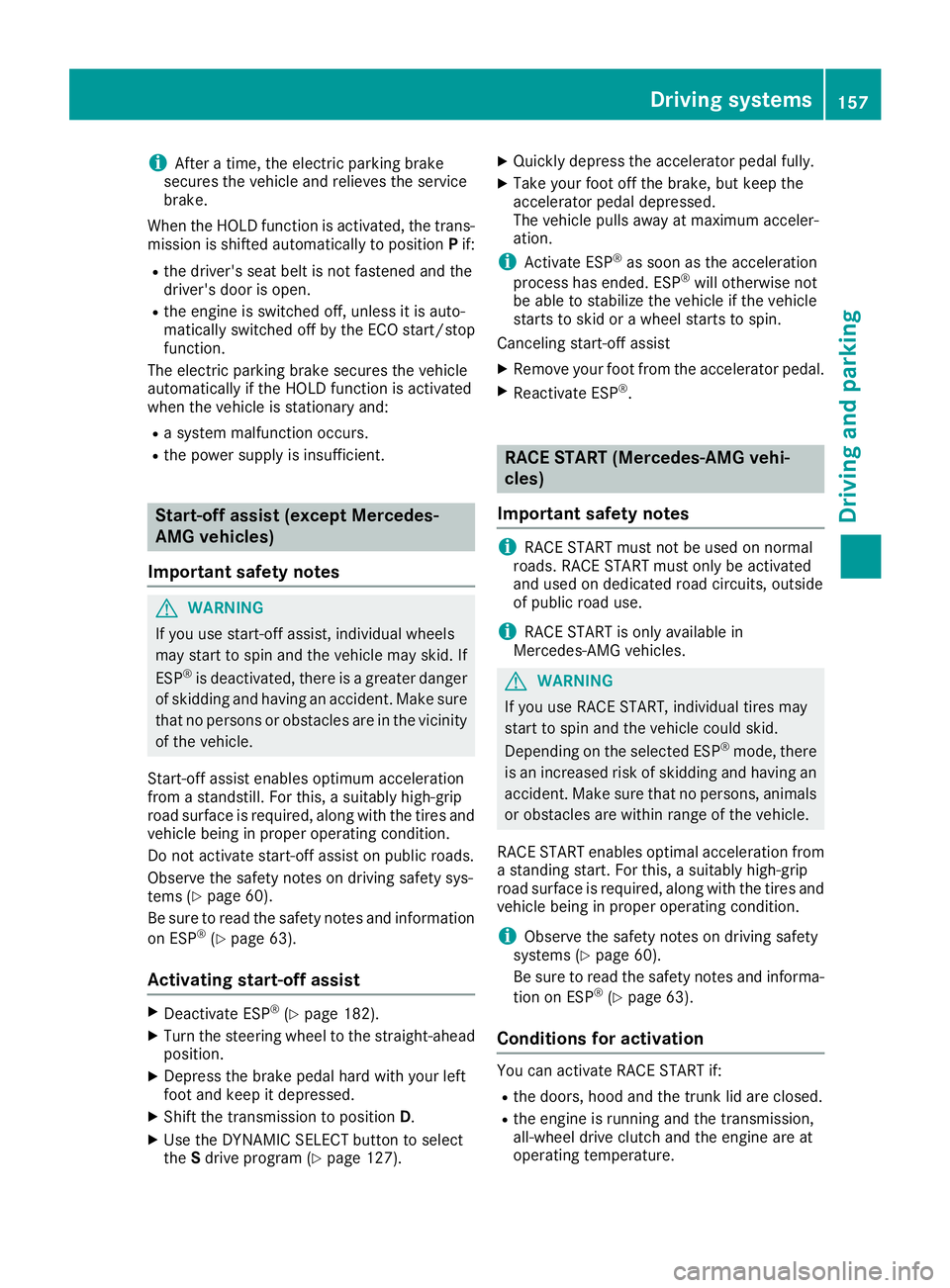
i After a time, the electric parking brake
secures the vehicle and relieves the service
brake.
When the HOLD function is activated, the trans-
mission is shifted automatically to position P if:R
the driver's seat belt is not fastened and the
driver's door is open. R
the engine is switched off, unless it is auto-
matically switched off by the ECO start/stop
function.
The electric parking brake secures the vehicle
automatically if the HOLD function is activated
when the vehicle is stationary and: R
a system malfunction occurs. R
the power supply is insufficient.
Start-off assist (except Mercedes-
AMG vehicles)
Important safety notes
G WARNING
If you use start-off assist, individual wheels
may start to spin and the vehicle may skid. If
ESP ®
is deactivated, there is a greater danger
of skidding and having an accident. Make sure
that no persons or obstacles are in the vicinity
of the vehicle.
Start-off assist enables optimum acceleration
from a standstill. For this, a suitably high-grip
road surface is required, along with the tires and
vehicle being in proper operating condition.
Do not activate start-off assist on public roads.
Observe the safety notes on driving safety sys-
tems ( Y
page 60).
Be sure to read the safety notes and information
on ESP ®
( Y
page 63).
Activating start-off assist X
Deactivate ESP ®
( Y
page 182).X
Turn the steering wheel to the straight-ahead
position. X
Depress the brake pedal hard with your left
foot and keep it depressed. X
Shift the transmission to position D .X
Use the DYNAMIC SELECT button to select
the S drive program ( Y
page 127). X
Quickly depress the accelerator pedal fully. X
Take your foot off the brake, but keep the
accelerator pedal depressed.
The vehicle pulls away at maximum acceler-
ation.
i Activate ESP ®
as soon as the acceleration
process has ended. ESP ®
will otherwise not
be able to stabilize the vehicle if the vehicle
starts to skid or a wheel starts to spin.
Canceling start-off assist X
Remove your foot from the accelerator pedal. X
Reactivate ESP ®
.
RACE START (Mercedes-AMG vehi-
cles)
Important safety notes
i RACE START must not be used on normal
roads. RACE START must only be activated
and used on dedicated road circuits, outside
of public road use.
i RACE START is only available in
Mercedes ‑ AMG vehicles.
G WARNING
If you use RACE START, individual tires may
start to spin and the vehicle could skid.
Depending on the selected ESP ®
mode, there
is an increased risk of skidding and having an
accident. Make sure that no persons, animals
or obstacles are within range of the vehicle.
RACE START enables optimal acceleration from
a standing start. For this, a suitably high-grip
road surface is required, along with the tires and
vehicle being in proper operating condition.
i Observe the safety notes on driving safety
systems ( Y
page 60).
Be sure to read the safety notes and informa-
tion on ESP ®
( Y
page 63).
Conditions for activation
You can activate RACE START if: R
the doors, hood and the trunk lid are closed. R
the engine is running and the transmission,
all-wheel drive clutch and the engine are at
operating temperature.Driving systems 157
Driving an d parking Z
Page 169 of 318
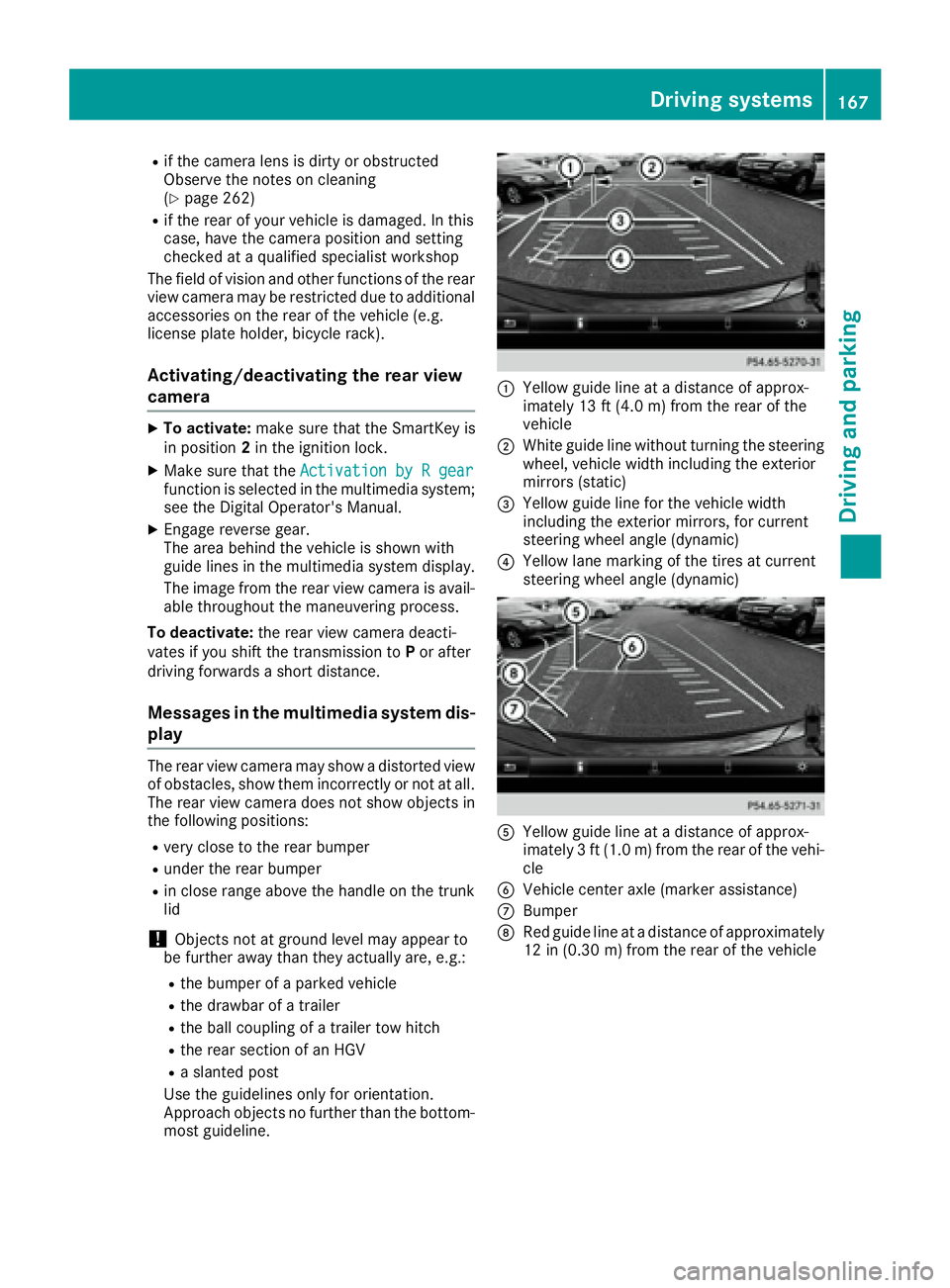
R
if the camera lens is dirty or obstructed
Observe the notes on cleaning
( Y
page 262) R
if the rear of your vehicle is damaged. In this
case, have the camera position and setting
checked at a qualified specialist workshop
The field of vision and other functions of the rear
view camera may be restricted due to additional
accessories on the rear of the vehicle (e.g.
license plate holder, bicycle rack).
Activating/deactivating the rear view
camera X
To activate: make sure that the SmartKey is
in position 2 in the ignition lock.X
Make sure that the Activation by R gear
function is selected in the multimedia system;
see the Digital Operator's Manual. X
Engage reverse gear.
The area behind the vehicle is shown with
guide lines in the multimedia system display.
The image from the rear view camera is avail-
able throughout the maneuvering process.
To deactivate: the rear view camera deacti-
vates if you shift the transmission to P or after
driving forwards a short distance.
Messages in the multimedia system dis-
play The rear view camera may show a distorted view
of obstacles, show them incorrectly or not at all.
The rear view camera does not show objects in
the following positions: R
very close to the rear bumper R
under the rear bumper R
in close range above the handle on the trunk
lid
! Objects not at ground level may appear to
be further away than they actually are, e.g.: R
the bumper of a parked vehicle R
the drawbar of a trailer R
the ball coupling of a trailer tow hitch R
the rear section of an HGV R
a slanted post
Use the guidelines only for orientation.
Approach objects no further than the bottom-
most guideline. �C
Yellow guide line at a distance of approx-
imately 13 ft (4.0 m) from the rear of the
vehicle �D
White guide line without turning the steering
wheel, vehicle width including the exterior
mirrors (static) �
Page 235 of 318
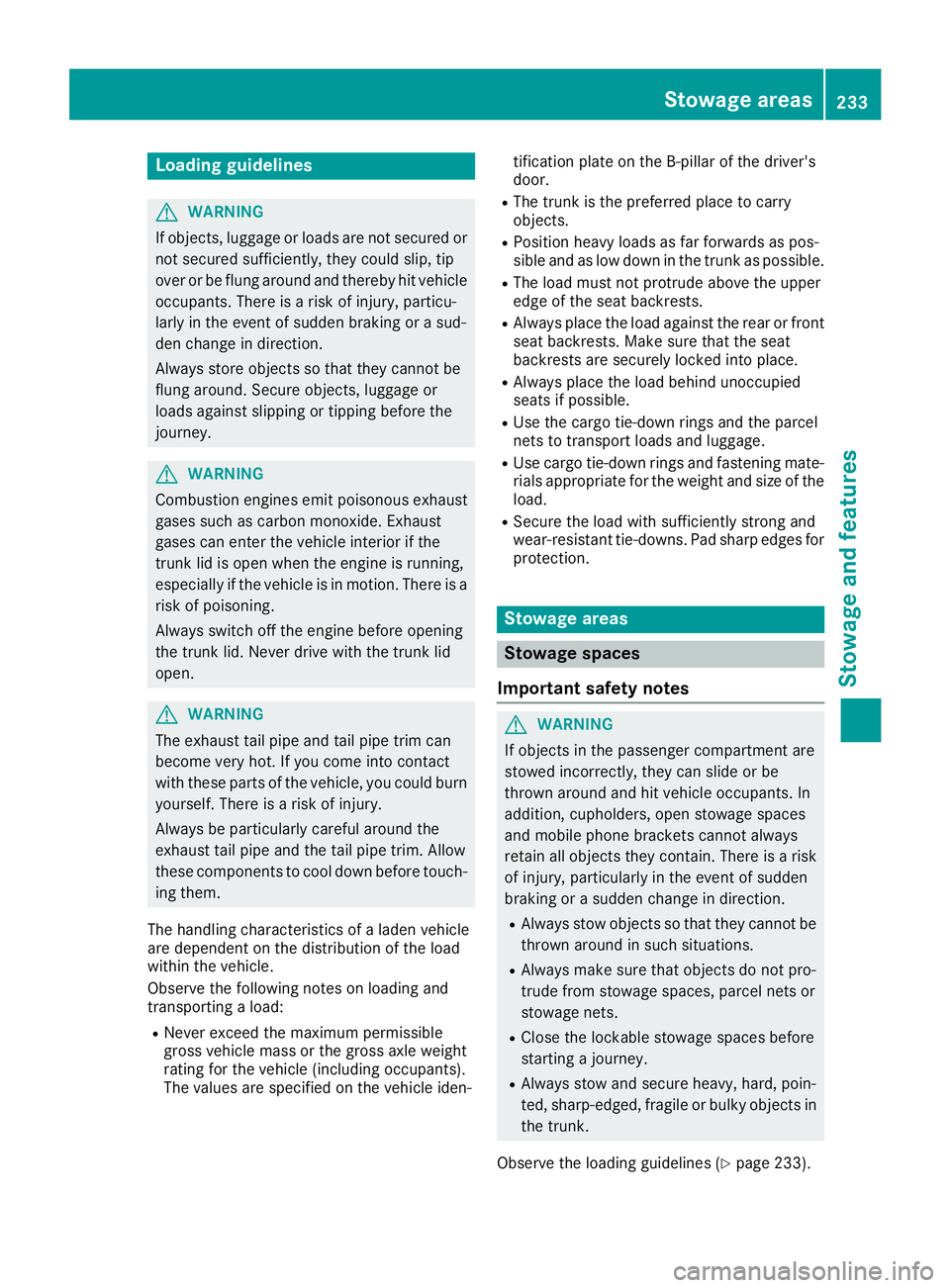
Loading guidelines
G WARNING
If objects, luggage or loads are not secured or
not secured sufficiently, they could slip, tip
over or be flung around and thereby hit vehicle
occupants. There is a risk of injury, particu-
larly in the event of sudden braking or a sud-
den change in direction.
Always store objects so that they cannot be
flung around. Secure objects, luggage or
loads against slipping or tipping before the
journey.
G WARNING
Combustion engines emit poisonous exhaust
gases such as carbon monoxide. Exhaust
gases can enter the vehicle interior if the
trunk lid is open when the engine is running,
especially if the vehicle is in motion. There is a
risk of poisoning.
Always switch off the engine before opening
the trunk lid. Never drive with the trunk lid
open.
G WARNING
The exhaust tail pipe and tail pipe trim can
become very hot. If you come into contact
with these parts of the vehicle, you could burn
yourself. There is a risk of injury.
Always be particularly careful around the
exhaust tail pipe and the tail pipe trim. Allow
these components to cool down before touch-
ing them.
The handling characteristics of a laden vehicle
are dependent on the distribution of the load
within the vehicle.
Observe the following notes on loading and
transporting a load: R
Never exceed the maximum permissible
gross vehicle mass or the gross axle weight
rating for the vehicle (including occupants).
The values are specified on the vehicle iden- tification plate on the B-pillar of the driver's
door. R
The trunk is the preferred place to carry
objects. R
Position heavy loads as far forwards as pos-
sible and as low down in the trunk as possible. R
The load must not protrude above the upper
edge of the seat backrests. R
Always place the load against the rear or front
seat backrests. Make sure that the seat
backrests are securely locked into place. R
Always place the load behind unoccupied
seats if possible. R
Use the cargo tie-down rings and the parcel
nets to transport loads and luggage. R
Use cargo tie-down rings and fastening mate-
rials appropriate for the weight and size of the
load. R
Secure the load with sufficiently strong and
wear-resistan t tie-downs. Pad sharp edges for
protection.
Stowage areas
Stowage spaces
Important safety notes
G WARNING
If objects in the passenger compartment are
stowed incorrectly, they can slide or be
thrown around and hit vehicle occupants. In
addition, cupholders, open stowage spaces
and mobile phone brackets cannot always
retain all objects they contain. There is a risk
of injury, particularly in the event of sudden
braking or a sudden change in direction. R
Always stow objects so that they cannot be
thrown around in such situations. R
Always make sure that objects do not pro-
trude from stowage spaces, parcel nets or
stowage nets. R
Close the lockable stowage spaces before
starting a journey. R
Always stow and secure heavy, hard, poin-
ted, sharp-edged, fragile or bulky objects in
the trunk.
Observe the loading guidelines ( Y
page 233).Stowage areas 233
Stowage and features Z
Page 237 of 318
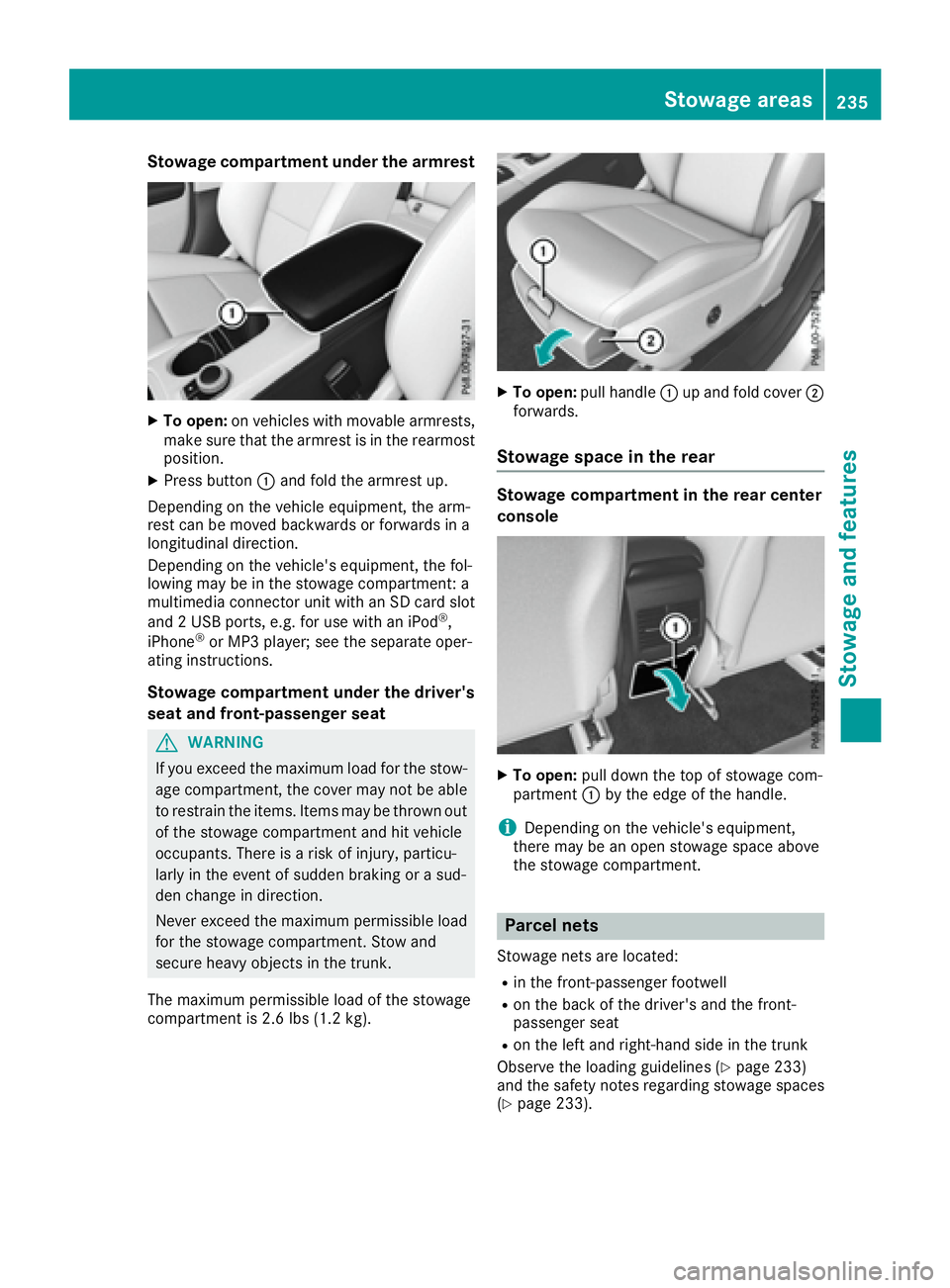
Stowage compartment under the armrest X
To open: on vehicles with movable armrests,
make sure that the armrest is in the rearmost
position. X
Press button �C and fold the armrest up.
Depending on the vehicle equipment, the arm-
rest can be moved backwards or forwards in a
longitudinal direction.
Depending on the vehicle's equipment, the fol-
lowing may be in the stowage compartment: a
multimedia connector unit with an SD card slot
and 2 USB ports, e.g. for use with an iPod ®
,
iPhone ®
or MP3 player; see the separate oper-
ating instructions.
Stowage compartment under the driver's
seat and front-passenger seat
G WARNING
If you exceed the maximum load for the stow-
age compartment, the cover may not be able
to restrain the items. Items may be thrown out
of the stowage compartment and hit vehicle
occupants. There is a risk of injury, particu-
larly in the event of sudden braking or a sud-
den change in direction.
Never exceed the maximum permissible load
for the stowage compartment. Stow and
secure heavy objects in the trunk.
The maximum permissible load of the stowage
compartment is 2.6 lbs (1.2 kg). X
To open: pull handle �C up and fold cover �D
forwards.
Stowage space in the rear Stowage compartment in the rear center
console
X
To open: pull down the top of stowage com-
partment �C by the edge of the handle.
i Depending on the vehicle's equipment,
there may be an open stowage space above
the stowage compartment.
Parcel nets Stowage nets are located: R
in the front-passenger footwell R
on the back of the driver's and the front-
passenger seat R
on the left and right-hand side in the trunk
Observe the loading guidelines ( Y
page 233)
and the safety notes regarding stowage spaces
( Y
page 233).Stowage areas 235
Stowage and features Z
Page 239 of 318
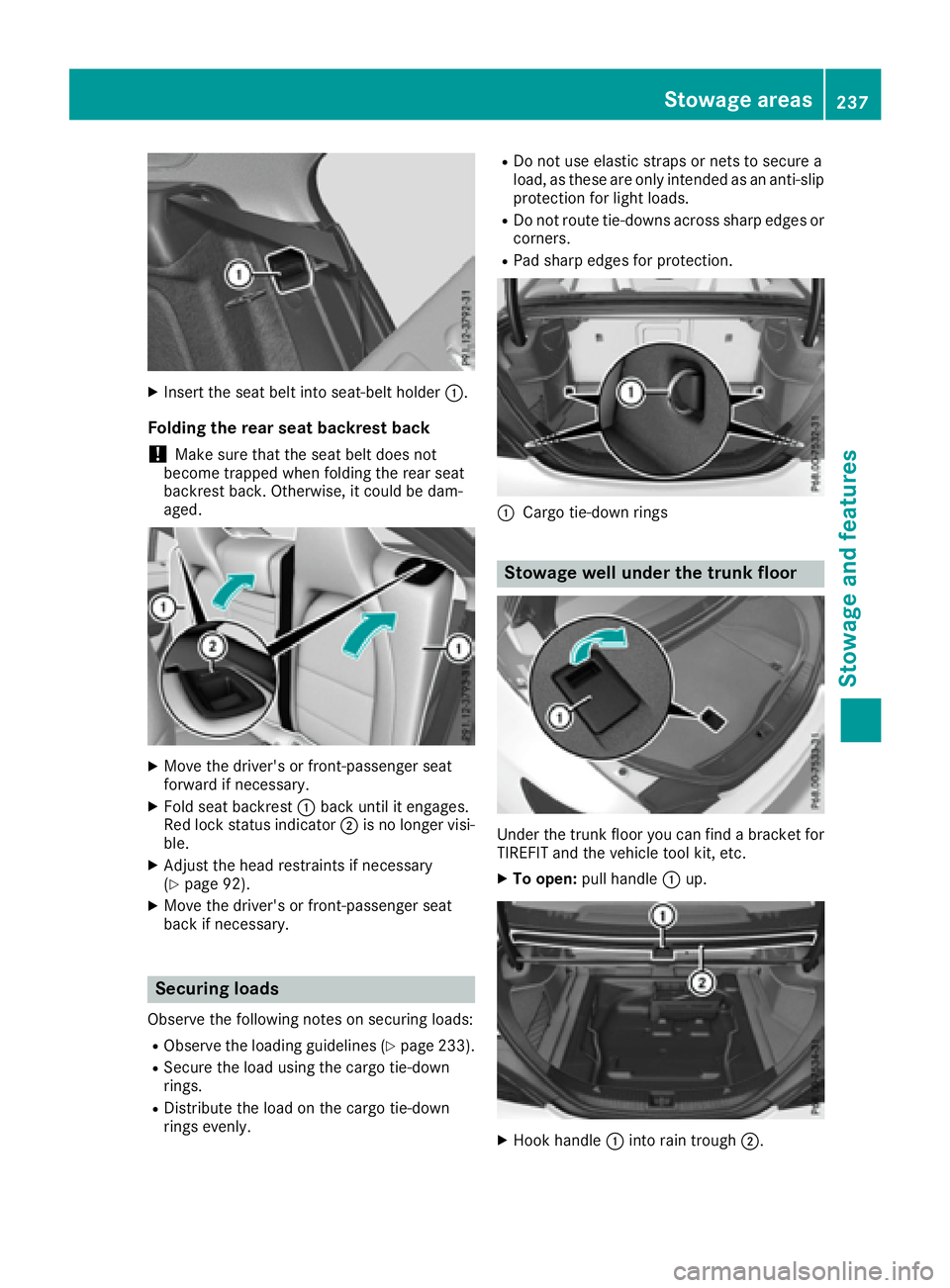
X
Insert the seat belt into seat-belt holder �C .
Folding the rear seat backrest back
! Make sure that the seat belt does not
become trapped when folding the rear seat
backrest back. Otherwise, it could be dam-
aged.
X
Move the driver's or front-passenger seat
forward if necessary. X
Fold seat backrest �C back until it engages.
Red lock status indicator �D is no longer visi-
ble. X
Adjust the head restraints if necessary
( Y
page 92). X
Move the driver's or front-passenger seat
back if necessary.
Securing loads
Observe the following notes on securing loads: R
Observe the loading guidelines ( Y
page 233).R
Secure the load using the cargo tie-down
rings. R
Distribute the load on the cargo tie-down
rings evenly. R
Do not use elastic straps or nets to secure a
load, as these are only intended as an anti-slip
protection for light loads. R
Do not route tie-downs across sharp edges or
corners. R
Pad sharp edges for protection.
�C
Cargo tie-down rings
Stowage well under the trunk floor
Under the trunk floor you can find a bracket for
TIREFIT and the vehicle tool kit, etc. X
To open: pull handle �C up.
X
Hook handle �C into rain trough �D .Stowage areas 237
Stowage and features Z
Page 240 of 318
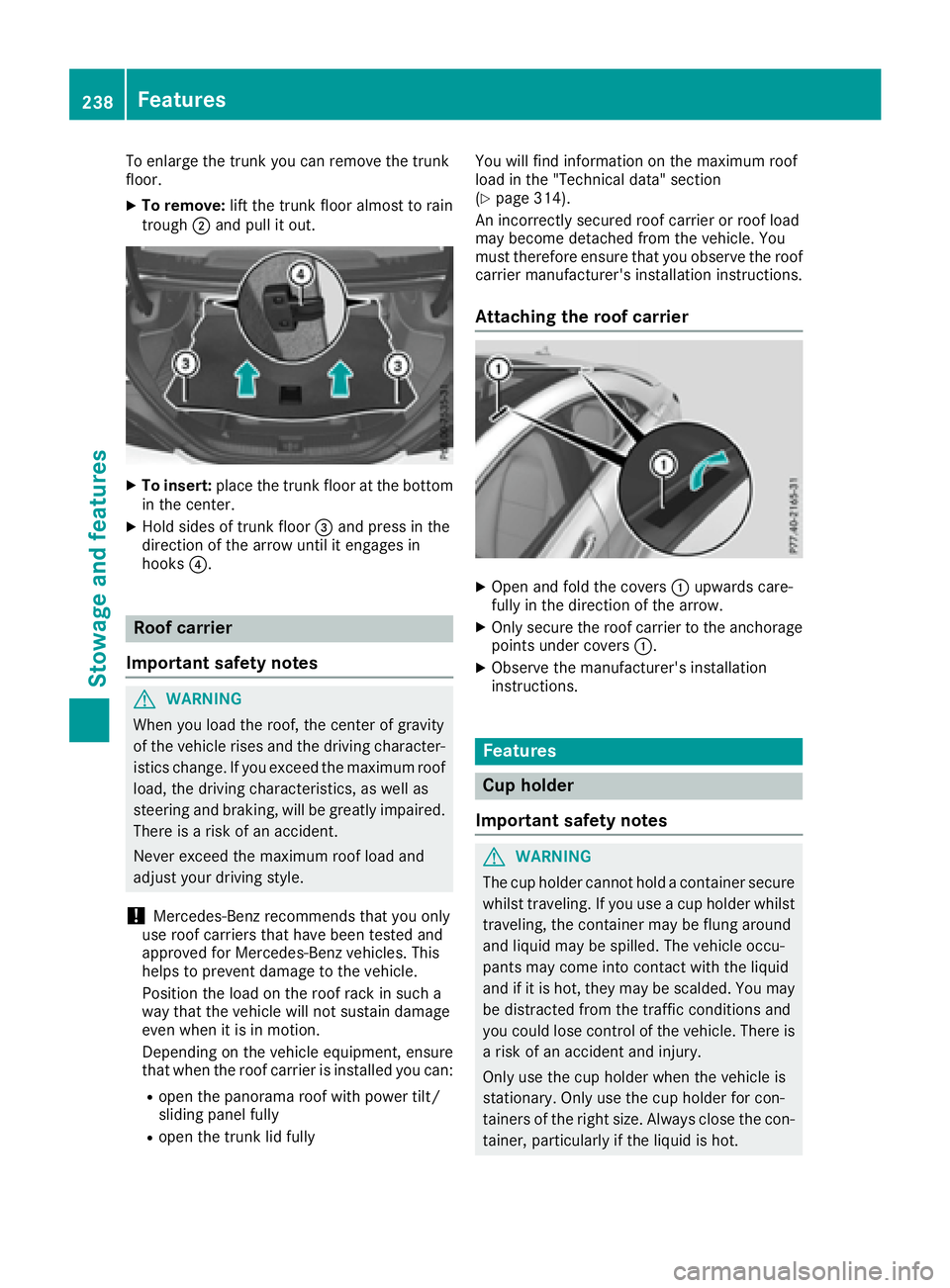
To enlarge the trunk you can remove the trunk
floor. X
To remove: lift the trunk floor almost to rain
trough �D and pull it out.
X
To insert: place the trunk floor at the bottom
in the center. X
Hold sides of trunk floor �
Page 241 of 318
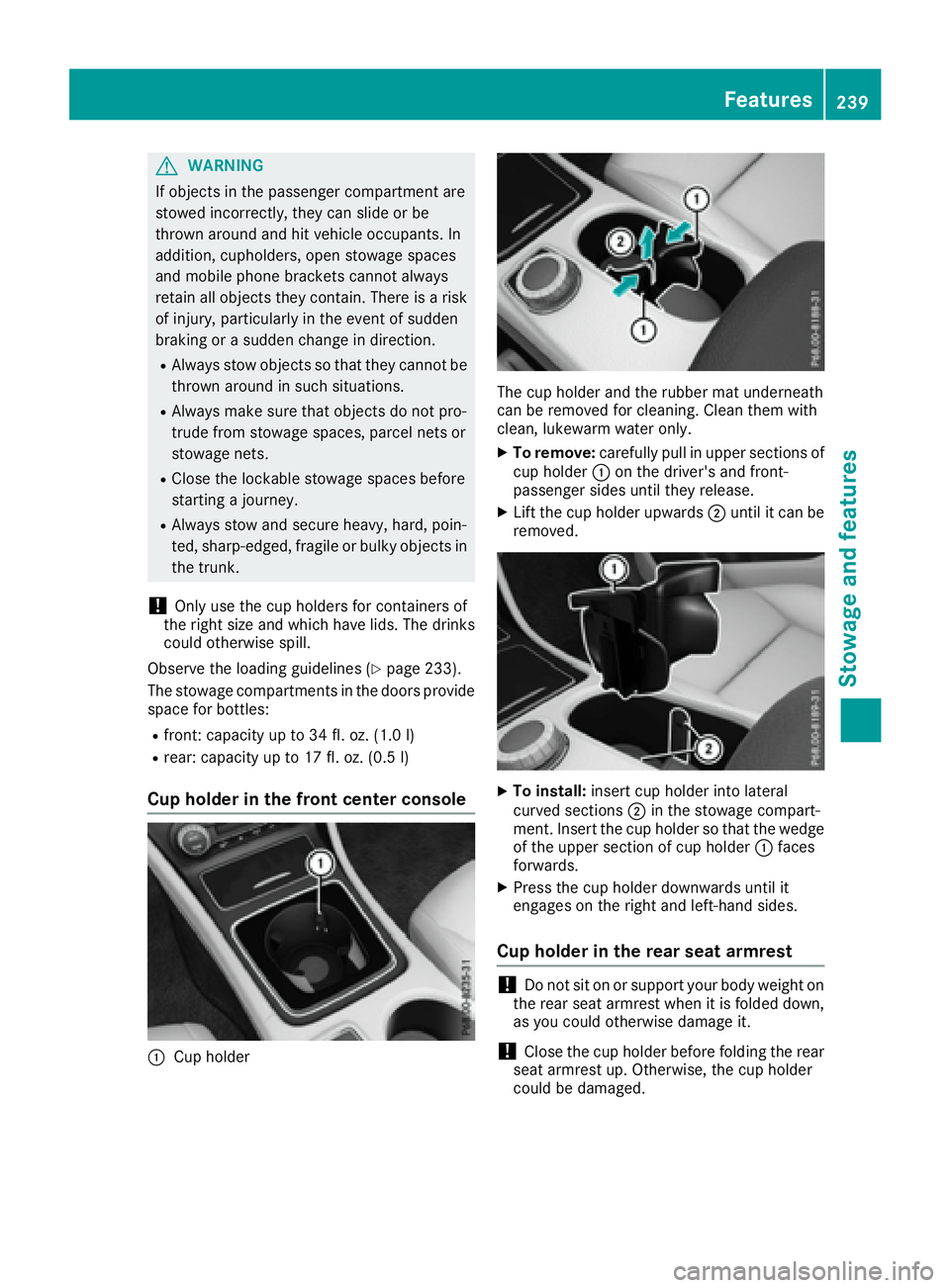
G WARNING
If objects in the passenger compartment are
stowed incorrectly, they can slide or be
thrown around and hit vehicle occupants. In
addition, cupholders, open stowage spaces
and mobile phone brackets cannot always
retain all objects they contain. There is a risk
of injury, particularly in the event of sudden
braking or a sudden change in direction. R
Always stow objects so that they cannot be
thrown around in such situations. R
Always make sure that objects do not pro-
trude from stowage spaces, parcel nets or
stowage nets. R
Close the lockable stowage spaces before
starting a journey. R
Always stow and secure heavy, hard, poin-
ted, sharp-edged, fragile or bulky objects in
the trunk.
! Only use the cup holders for containers of
the right size and which have lids. The drinks
could otherwise spill.
Observe the loading guidelines ( Y
page 233).
The stowage compartments in the doors provide
space for bottles: R
front: capacity up to 34 fl. oz. (1.0 l)R
rear: capacity up to 17 fl. oz. (0.5 l)
Cup holder in the front center console
�C
Cup holder The cup holder and the rubber mat underneath
can be removed for cleaning. Clean them with
clean, lukewarm water only. X
To remove: carefully pull in upper sections of
cup holder �C on the driver's and front-
passenger sides until they release. X
Lift the cup holder upwards �D until it can be
removed.
X
To install: insert cup holder into lateral
curved sections �D in the stowage compart-
ment. Insert the cup holder so that the wedge
of the upper section of cup holder �C faces
forwards. X
Press the cup holder downwards until it
engages on the right and left-hand sides.
Cup holder in the rear seat armrest
! Do not sit on or support your body weight on
the rear seat armrest when it is folded down,
as you could otherwise damage it.
! Close the cup holder before folding the rear
seat armrest up. Otherwise, the cup holder
could be damaged. Features 239
Stowage and features Z